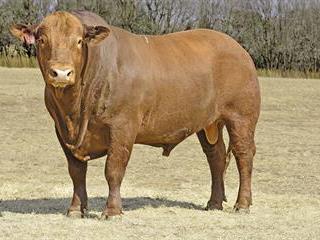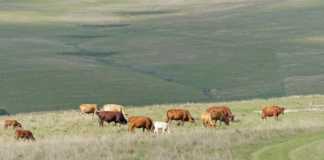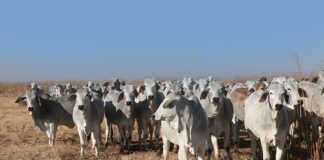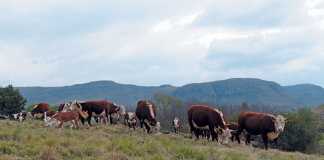
“It’s a once-in-a-lifetime price and it opens doors.” So says Flippie Kotze about the South African record price he achieved last year with his Twee Plus Brangus bull, Master Jack (T+ 12 120).
But the highly fertile Twee Plus Brangus Stud is about much more than just one exceptional bull. The Kotze family have been finalists in two of the country’s most prestigious livestock competitions: the 2012 Molatek Beef Producer of the Year and the 2015 Voermol National Cattle Farmer of the Year.
Bouncing back with Brangus
The current success of the Twee Plus Brangus stud belies the fact that the Kotzes (Flippie and Marieta and their sons Flippie Jnr and Walter) have faced serious challenges in the past. In fact, the family lost their 2 300ha farm Swartfontein – located in the Aliwal North district – in the early 1990s when Flippie overinvested in a feedlot that was purported to have had the potential to finish off 1 000 cattle at a time. By 1995, however, they had recovered sufficiently to be able to buy back Swartfontein.
Although the Kotzes had by then sourced about 140 Bonsmara cows from Colesberg farmer, Theo Gilfillan, they were determined to incorporate Brahman genetics into their beef operation. They began by acquiring two Brangus bulls from Welkom in the Free State in 1996, and it was their offspring that converted the Kotzes to the Brangus breed.
“The first crossbred calves were impressive and we decided to continue using Brangus bulls,’’ says Flippie. “We always thought you can’t move away completely from a Brahman.’’
Establishing the stud
When Walter returned to farm in 1999 (Flippie Jr had by then established himself as a combining contractor near Bultfontein in the Free State), it was decided to develop the farm vertically by establishing a Brangus stud. From then on, only quality bulls were acquired from the annual Brangus National Sale.

Flippie Kotze and his son, Walter, on Swartfontein. ‘If you don’t care for your cattle, they won’t care for you,’ says Walter. (Photo by Mike Burgess)
In 2006, the Kotzes followed this up by deciding to select their best cows and sell undesirable animals. In the same year, they purchased 27 top Brangus stud cows from Ido Schroeder’s Burmeister Brangus Stud in KwaZulu- Natal. This decision would revolutionise the herd.
‘’The cows were expensive,’’ admits Walter. “But they resulted in a positive turn in the herd and we registered the stud in 2010.’’
Another important genetic influence in the Twee Plus Brangus herd was the 2012 SA Junior Champion Brangus bull (V5 1036), which the Kotzes bought for R125 000 at that year’s Brangus National Sale. “When it comes to good genetics, one has to pay for it and not try to save,’’ says Walter. “This bull made a telling contribution to the herd.’’
Exceptional fertility
Possibly the most outstanding feature of the Twee Plus Brangus herd is its fertility. Medium- framed females with an average weight of 461kg calve from August to November, and in 2015 achieved an overall weaning rate of almost 96%. What’s more, the weaners (weaned at about seven months), weighed an average of 254kg (bull calves) and 238kg (heifer calves) at 200 days. This translates to an average calf:cow weight ratio at weaning of close to 50%.
In 2013, the Twee Plus Brangus herd was the most fertile Brangus herd in the country, boasting an average herd ICP of 368 days. Currently, the average herd ICP is 372 days, while the most fertile cows boast ICPs of as low as 320 days.
Heifers calve between the ages of 20 and 24 months. In fact, Flippie says with annoyance that some heifer calves as young as six months have conceived, thanks to bull calves walking with their mothers before weaning.
Achieving high fertility
In addition to outstanding genetics, extra feed plays a critical role, according to the Kotzes. Although some cattle breeders believe that fertility should be measured by a cow’s productivity on the veld, Flippie and Walter disagree. “Many people have the idea that cattle must survive and breed on the veld. But I feel we don’t farm with survivors. We farm with ‘producers,’ and a ‘producer’ is something that gives me back double what I give it,’’ explains Flippie.
Therefore, in addition to a standard lick supplementation regime, the Kotzes have ensured that their 370ha (170ha under irrigation) cropping operation plays an important role in the beef enterprise. They grow lucerne, wheat, maize, sugargraze, triticale, sugar beans and potatoes on Swartfontein as well as on a second farm, De Hoop (174ha), along the Kraai River.
Crop residues are used as feed for the beef herd, while the sugargraze summer forage crop helps heifers reach a weight of 350kg (pelvic measurements are also done) before mating at an average age of 13 months. The winter forage crop of triticale, on the other hand, plays a critical role in supplying first-calvers with ample support to successfully produce the all important second calf – arguably a cow’s greatest challenge in life, says Flippie.
Selling and buying genetics
The sale of Master Jack (2015 Brangus Breedplan Bull, 2015 LBW/Breedplan/Zoetis Bull, and 2015 SA Senior, Grand and Supreme Champion Brangus Bull) for a South African record- price to David Mashinini of Bethlehem in the Free State, proved to be a turning point in the Kotzes’ appreciation of their own Brangus genetics.
“We then realised that every year we buy bulls in, despite having good breeding bulls of our own,’’ says Flippie. “Master Jack’s half-brother was also at the national sale in 2015 and went for R85 000, but we decided to bring him back. He was the first bull to be used in our own herd.’’
Besides selling genetics at the national and East Cape Brangus Club sales, the Kotzes have also marketed genetics at the Trio B Brangus Production Sale held near Bloemfontein in 2012 and 2013 (R28 000 and R22 000 were achieved for 10-month old open heifers in 2012).
In 2014, genetics were marketed at the Performance Alliance Production Sale held near Theunissen in the Free State, which included animals from V5 Brangus, Trio B Brangus, Aanstoot Brangus and Comei Brangus.
In October 2015, Twee Plus Brangus held its first production sale on Swartfontein, selling almost 100 animals, including 25 bulls (achieving an average price of R22 000), and 15 top cows, all with ICPs under 370 days and individual calf:cow weight ratios (at weaning) of between 45% and 64%.
Flippie and Walter stress that they never market culls at production sales to ensure that customers are exposed only to exceptional genetics. “A buyer must feel that buying from us is worth his while,’’ says Flippie.
Phone Walter Kotze on 073 494 6494, or Flippie Kotze on 082 955 6665.













